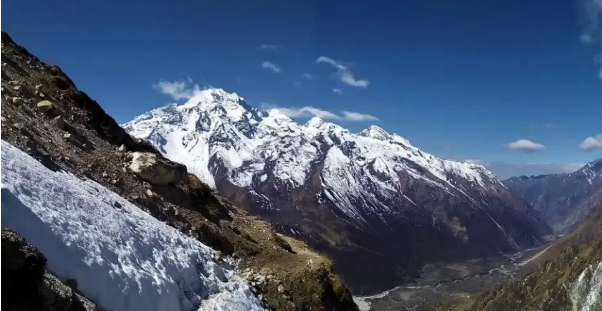The Langtang Valley Trek stands as one of Nepal’s most accessible yet spectacular trekking destinations, offering an extraordinary blend of pristine wilderness, rich cultural heritage, and breathtaking mountain vistas. Located just north of Kathmandu, this remarkable journey takes adventurers through the heart of Langtang National Park, where ancient Tibetan traditions meet dramatic Himalayan landscapes.
Overview of the Langtang Valley Trek
Situated in the Rasuwa District of Nepal, the Langtang Valley Trek is often referred to as the “Valley of Glaciers” due to its stunning glacial formations and towering peaks. This moderate-difficulty trek typically spans 7-12 days, depending on the chosen itinerary and acclimatization requirements. The trail reaches its highest point at Kyanjin Gompa (3,870m), making it more accessible than many other high-altitude treks in the region.
The trek gained international recognition not only for its natural beauty but also for the resilience of its communities following the devastating 2015 earthquake. Today, the region has been thoughtfully rebuilt, welcoming trekkers with renewed hospitality and improved infrastructure while maintaining its authentic cultural character.
Route Description and Highlights
The Langtang Valley Trek traditionally begins with a scenic drive from Kathmandu to Syabrubesi, the gateway to the valley. This journey itself offers glimpses of rural Nepalese life and terraced hillsides. From Syabrubesi, the trekking trail follows the Langtang River, gradually ascending through diverse ecosystems.
The initial days lead through subtropical forests rich with rhododendrons, oak, and bamboo, where wildlife enthusiasts might spot red pandas, Himalayan black bears, and various bird species. As elevation increases, the landscape transforms into alpine meadows and eventually reaches the stark beauty of the high-altitude zone.
Key highlights along the route include the traditional Tamang village of Langtang, where ancient Buddhist culture thrives amidst prayer flags and stone stupas. The trek culminates at Kyanjin Gompa, an ancient monastery surrounded by towering peaks including Langtang Lirung (7,227m), Kimshung (6,781m), and Langtang Ri (7,205m).
Cultural Significance and Local Communities

The Langtang region is predominantly inhabited by the Tamang people, whose Tibetan Buddhist heritage is evident throughout the valley. These communities have maintained their traditional lifestyle for centuries, practicing agriculture, yak herding, and cheese production. The famous Langtang cheese, produced in local factories, has become a regional specialty that trekkers often sample during their journey.
Villages like Kyanjin Ri and Langtang offer authentic cultural experiences, where visitors can witness traditional architecture, participate in local festivals, and learn about sustainable mountain living. The reconstruction efforts following the 2015 earthquake have been remarkable, with communities working together to rebuild not just structures but also their tourism-dependent economy.
Best Time to Visit
The Langtang Valley Trek is best undertaken during two primary seasons. Spring (March to May) offers mild temperatures, clear mountain views, and the spectacular blooming of rhododendrons that paint the hillsides in vibrant colors. This season provides excellent visibility and comfortable trekking conditions.
Autumn (September to November) is equally favorable, featuring stable weather patterns, crystal-clear mountain vistas, and comfortable daytime temperatures. Winter trekking is possible but requires proper preparation for cold conditions and potential snow, while monsoon season (June to August) brings heavy rainfall and obscured mountain views.
Physical Preparation and Difficulty Level
The Langtang Valley Trek is classified as moderate difficulty, making it suitable for trekkers with basic fitness levels and some hiking experience. The daily walking distances range from 4-7 hours, with gradual altitude gain that allows for proper acclimatization.
Preparation should include regular cardiovascular exercise, hiking practice with a loaded backpack, and leg strengthening exercises. While technical climbing skills are not required, good physical conditioning significantly enhances the trekking experience and reduces the risk of altitude-related issues.
Essential Permits and Regulations
Trekkers require two primary permits for the Langtang Valley Trek. The Langtang National Park Entry Permit costs approximately $30 for foreign nationals and can be obtained in Kathmandu or at the park entrance. Additionally, the TIMS (Trekkers’ Information Management System) card is mandatory and costs around $20 for independent trekkers.
These permits support conservation efforts and local development projects while ensuring trekker safety through registration systems. It’s advisable to carry multiple passport-sized photographs and copies of your passport for permit applications.
Accommodation and Dining Options
The Langtang Valley Trek offers comfortable teahouse accommodation throughout the route, providing basic but clean lodging with shared facilities. These family-run establishments offer authentic Nepalese hospitality and home-cooked meals featuring local ingredients.
Dining options include traditional dal bhat (rice and lentils), momos (dumplings), noodle soups, and international dishes adapted for trekkers’ preferences. The famous Langtang cheese features prominently in local cuisine, often served with traditional bread and vegetables.
Wildlife and Natural Features
Langtang National Park encompasses diverse ecosystems supporting rich biodiversity. The park is home to over 250 bird species, including the colorful Himalayan monal and various pheasants. Mammals include the elusive red panda, Himalayan tahr, and occasionally, snow leopards in higher elevations.
The valley’s geological features include ancient glacial moraines, pristine alpine lakes, and dramatic rock formations. The Langtang Glacier, visible from various viewpoints, demonstrates the powerful forces that shaped this remarkable landscape over millennia.
Conclusion
The Langtang Valley Trek represents an exceptional opportunity to experience the Himalayas’ raw beauty while supporting resilient mountain communities. This accessible yet rewarding journey offers the perfect introduction to high-altitude trekking, combining moderate physical challenges with profound cultural experiences and spectacular natural scenery.
Whether you’re seeking adventure, cultural immersion, or simply the therapeutic benefits of mountain wilderness, the Langtang Valley Trek delivers an unforgettable experience that will leave lasting memories and a deep appreciation for Nepal’s mountain heritage. The valley’s recovery and renewal following natural disasters serve as an inspiring testament to human resilience and the enduring allure of the Himalayas.
Frequently Asked Questions
Q: How long does the Langtang Valley Trek take? A: The standard Langtang Valley Trek typically takes 7-12 days, depending on your chosen itinerary, acclimatization needs, and optional side trips to viewpoints like Tserko Ri.
Q: What is the maximum altitude reached during the trek? A: The highest point of the standard trek is Kyanjin Gompa at 3,870 meters. Optional climbs to Tserko Ri can reach 4,984 meters for panoramic mountain views.
Q: Is the Langtang Valley Trek suitable for beginners? A: Yes, the trek is considered moderate difficulty and suitable for beginners with good fitness levels. Previous trekking experience is helpful but not essential.
Q: What should I pack for the Langtang Valley Trek? A: Essential items include layered clothing for varying temperatures, waterproof gear, comfortable hiking boots, sleeping bag, and personal medications. A detailed packing list should be obtained from your trekking operator.
Q: Are there ATM facilities along the trekking route? A: No, there are no ATM facilities along the trek. Bring sufficient Nepalese rupees in cash from Kathmandu for all expenses including accommodation, meals, and permits.
Q: How has the region recovered from the 2015 earthquake? A: The Langtang region has made remarkable recovery progress with rebuilt infrastructure, improved trails, and renewed community-based tourism initiatives. The area is now safe and welcoming for trekkers.

